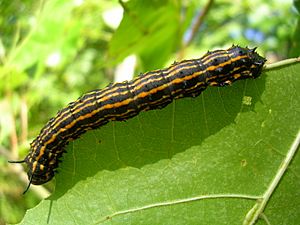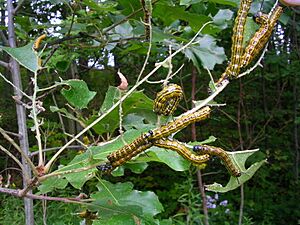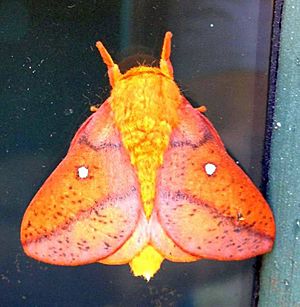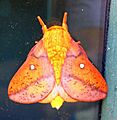Orangestriped oakworm facts for kids
Quick facts for kids Orangestriped oakworm |
|
|---|---|
 |
|
| Caterpillar | |
| Scientific classification | |
| Synonyms | |
|
The orangestriped oakworm (scientific name: Anisota senatoria) is a type of moth found in North America. It belongs to the Saturniidae family, which includes many large moths. Sometimes, these moths can become quite numerous and cause problems for trees in the northern parts of their habitat. However, they usually don't cause lasting damage because they eat leaves later in the year, after the trees have already stored most of their energy.
This moth looks very similar to other moths like A. finlaysoni in southern Ontario and A. peigleri in the southern United States. The orangestriped oakworm was first described by a scientist named James Edward Smith in 1797.
Contents
Where Do They Live?
You can find the orangestriped oakworm across eastern North America. Their home stretches from the edge of the Great Plains all the way to the east coast. They live from southern Ontario in Canada down to central Georgia, Alabama, and eastern Texas in the USA. While they are found in northern Florida, they are much more common in the cooler northern areas.
Life Cycle of the Oakworm
The orangestriped oakworm has only one generation, or "brood," each year. This means they complete their entire life cycle from egg to adult only once a year.
From Egg to Caterpillar
Female moths lay their eggs in large groups on the underside of leaves. These eggs usually hatch into tiny caterpillars in about one to two weeks.
When they are young, the caterpillars like to stay together in groups. Even as they grow bigger, they often don't move far from each other. When they reach their fifth and final stage of growth (called the fifth instar), they are black with bright yellow-orange stripes along their sides. They also have two noticeable spiky horns on their second body segment, which can be about 5 centimeters (2 inches) long. Smaller spikes can be found on their other body parts. These caterpillars mostly eat oak leaves during August and September.
Becoming a Pupa
Just like many other moths in their group, when the caterpillars are ready to change into moths, they dig into the ground. Before they do this, you might see them crawling around on the ground, looking for the perfect spot to burrow and become a pupa.
The Adult Moth
Adult moths appear once a year to find a mate, usually from mid-June to mid-July. They mate in the middle of the day, and the females lay their eggs later in the day.
Interestingly, adult orangestriped oakworms do not eat at all! Their mouthparts are not fully developed, so they cannot feed. They rely on the energy they stored as caterpillars.
Female moths are usually quite chubby and have a yellow-orange color. They have a shiny silver-white spot and a faint black line across their front wings. There's also a line across their back wings. Male moths are much smaller and are more reddish-brown, but they also have the white spot and pale lines. Both male and female moths have small black speckles on their wings. Their wingspan, which is the distance from one wingtip to the other, is about 3 to 5 centimeters (1.2 to 2 inches).
What Do They Eat?
Orangestriped oakworm caterpillars mainly eat the leaves of Oak trees, especially red oaks. However, they have also been known to eat leaves from other trees like chestnut, birch, hazel, hickory, and maple.
Images for kids






